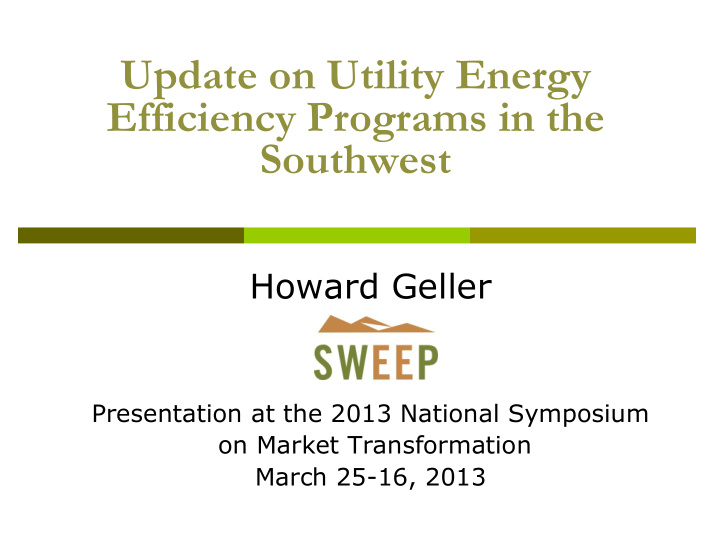



Update on Utility Energy Efficiency Programs in the Southwest Howard Geller Presentation at the 2013 National Symposium on Market Transformation March 25-16, 2013
Electric Utility DSM Program Spending Trends Electric DSM Program Spending/Budgets (million $ per year) 2013 State 2002 2004 2006 2008 2010 2012 (est.) AZ 4 4 19 45 94 120 140 CO 11 21 18 28 66 97 105 NV 3 11 30 55 46 37 50 NM 1 1 1 10 24 27 35 UT 9 16 27 36 51 46 51 WY ~0 ~0 ~0 ~0 3 4 5 Region 29 54 95 174 284 331 386
First Year Savings by Utility (GWh/yr) Savings from Programs Implemented Each Year 2500 2000 1500 1000 500 0 2007 2008 2009 2010 2011 2012 APS TEP SRP Xcel-CO RMP-UT NV Energy PNM
Energy Savings Trends by Utility Net Energy Savings as a % of Retail Sales, by program year 2.0% 1.8% 1.6% 1.4% 1.2% 1.0% 0.8% 0.6% 0.4% 0.2% 0.0% 2007 2008 2009 2010 2011 2012 APS TEP SRP Xcel-CO RMP-UT NV Energy PNM
Arizona EERS calls for IOUs to achieve savings of 1.75% in 2012 and 2.0% in 2013 (w/ 10% DR credit) APS achieved 1.8% savings in 2012 (first year savings as a fraction of sales), 25% more than savings achieved in 2011 TEP suspended programs in 2012 due to inadequate cost recovery and Commission inaction but restarted some programs in March 2013; pending rate case settlement calls for rate basing of DSM investment with 5 year amortization along with lost fixed cost recovery SRP also ramping up EE programs, achieved savings equal to 1.7% of sales in 2012 (including savings from pre-paid meters)
Colorado Xcel Energy and Black Hills Energy ramped up DSM programs over past 5 years in response to savings goals and incentives set by the PUC Xcel achieved 1.3% savings as a fraction of sales in 2012 (net savings basis), 27% more than savings in 2011 2013: Two dockets with Xcel starting in mid-year Strategic Issues – Reviews savings goals, incentive mechanism and other key policies 2014 DSM Program Plan Rural co-ops provide about 25% of electricity in CO and do very little to promote EE; legislation planned that includes EE standards for co-ops
Nevada Energy savings count towards RPS compliance, up to 25% of standard each year DSM funding levels and savings reduced in 2010- 12 due to deep economic recession, less need for EE resources in short run, and excess energy savings credits from previous years NV Energy still achieved 1% savings in 2011 and 0.7% savings in 2012 as fraction of sales Utility receiving lost revenue recovery in addition to cost recovery, proving to be very controversial Proposed legislation establishes separate savings standards and replaces LRR with decoupling and a performance-based shareholder incentive
New Mexico Energy savings requirements for IOUs: 5% savings in 2014 and 8% savings in 2020 (from programs implemented starting in 2008) Program approval has been challenging as has been approval of shareholder incentives PNM slowly ramping up programs; achieved about 0.8% savings in 2012 and proposing to achieve around 0.9% savings under new DSM plan Enacted 2013 legislation establishes 3% tariff rider for program funding, changes cost effectiveness test from TRC to UCT, and reduces 2020 standard from 10% to 8% (compromise with utilities and PRC)
Utah Utah does not have utility EE goals or standards, nor an electric utility disincentive removal or shareholder incentive mechanism Rocky Mountain Power (RMP) does have IRP requirements which drives investment in DSM programs; UCT is the principal benefit-cost test RMP has been achieving about 1% savings per year since 2009 2012-13 expansion includes Home Energy Reports and proposed C&I Strategic Energy Management program
SWEEP: Dedicated to More Efficient Energy Use in the Southwest Resources available online at: www.swenergy.org Howard Geller, Executive Director 303-447-0078x1 hgeller@swenergy.org
Recommend
More recommend